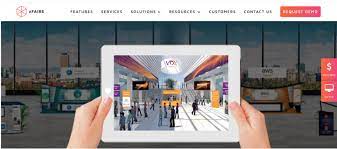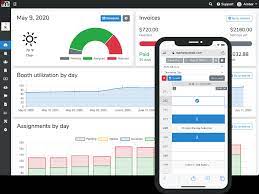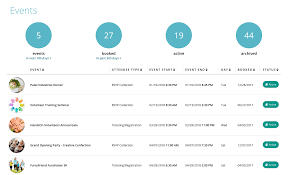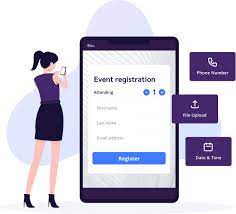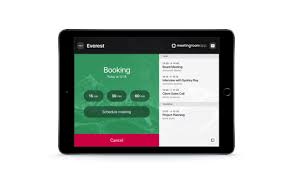Virtual Event Hosting Platforms: Revolutionizing the Way We Connect
In today’s fast-paced world, technology has become an integral part of our lives. From shopping to socializing, the digital realm has transformed the way we interact and conduct business. One area that has seen a significant shift is event hosting. With the rise of virtual event hosting platforms, the possibilities for connecting and engaging with audiences have expanded like never before.
A virtual event hosting platform is a comprehensive solution that enables organizations to create and host events online. These platforms offer an array of features designed to replicate the experience of attending an in-person event, all from the comfort of one’s own home or office. From conferences and trade shows to webinars and product launches, these platforms are revolutionizing how we approach events.
One of the key advantages of virtual event hosting platforms is their accessibility. Traditional events often require attendees to travel long distances, incur expenses, and take time away from work or family commitments. With virtual events, participants can join from anywhere in the world with just a few clicks. This opens up new opportunities for global collaboration and audience reach.
Moreover, virtual event hosting platforms provide a range of interactive features that enhance engagement and networking opportunities. Attendees can participate in live chats, Q&A sessions, polls, and surveys during presentations or panel discussions. They can also connect with fellow participants through virtual networking lounges or one-on-one video meetings. These features foster meaningful connections and facilitate knowledge sharing among attendees.
Another significant advantage is the ability to track data and analytics seamlessly. Virtual event hosting platforms offer real-time insights into attendee behavior, such as session attendance rates, engagement levels, and content preferences. This data empowers organizers to make informed decisions for future events while optimizing their strategies based on attendee feedback.
Virtual event hosting platforms also provide cost-effective solutions for organizers. Traditional events often involve substantial expenses related to venue rental, catering services, printed materials, and logistics. Virtual events eliminate many of these costs, allowing organizers to allocate resources more efficiently and potentially reach a larger audience without breaking the bank.
Despite these advantages, it’s important to note that virtual event hosting platforms cannot fully replace the value of in-person interactions. The energy and personal connections that come from physical events are unique experiences that cannot be replicated entirely online. However, virtual events provide an alternative solution during times when in-person gatherings are not feasible or when reaching a broader audience is essential.
As technology continues to evolve, virtual event hosting platforms will undoubtedly become more sophisticated and user-friendly. They will continue to bridge the gap between physical and digital experiences, offering innovative ways for individuals and organizations to connect, learn, and grow.
In conclusion, virtual event hosting platforms have transformed the landscape of event hosting by providing accessible, interactive, cost-effective solutions for organizations worldwide. As we embrace this digital revolution, we can expect virtual events to become an integral part of our future, offering exciting opportunities for engagement and collaboration on a global scale.
5 Essential Tips for Successful Virtual Event Hosting: Mastering the Platform, Engaging Your Audience, and Maximizing Reach
- Familiarize yourself with the virtual event hosting platform before the event to ensure a smooth experience for both you and your attendees.
- Have a backup plan in case of technical difficulties or other issues that could arise during your event.
- Utilize features such as polls, Q&A sessions, and chat rooms to engage with your audience and make the event more interactive.
- Take advantage of recording capabilities so you can share the content with those who were unable to attend or watch it at a later date.
- Promote your virtual event through social media channels and other forms of digital marketing to maximize reach and attendance numbers
Familiarize yourself with the virtual event hosting platform before the event to ensure a smooth experience for both you and your attendees.
Familiarize Yourself with the Virtual Event Hosting Platform: Ensuring a Seamless Experience
When it comes to hosting a successful virtual event, preparation is key. One important tip to ensure a smooth experience for both you as the host and your attendees is to familiarize yourself with the virtual event hosting platform well in advance of the event itself.
Virtual event hosting platforms offer a wide range of features and functionalities that can greatly enhance your event. However, these platforms may have their own unique interface, settings, and tools that you need to understand and navigate effectively. By taking the time to familiarize yourself with the platform beforehand, you can avoid any potential technical hiccups or last-minute troubleshooting during your event.
Start by exploring the platform’s user interface and dashboard. Get acquainted with the various sections, menus, and options available to you as the host. Take note of features such as live streaming capabilities, chat functions, presentation tools, and attendee management features. Understanding these elements will allow you to make full use of the platform’s capabilities during your event.
Next, consider conducting practice sessions or mock events using the platform. This will give you an opportunity to test out different features and settings in a controlled environment. Practice setting up presentations or panel discussions, managing attendee interactions through chats or Q&A sessions, and navigating between different areas of the platform. By doing so, you’ll gain confidence in using the platform effectively when it matters most.
Additionally, make sure to review any available tutorials or support documentation provided by the virtual event hosting platform. These resources often contain valuable tips and tricks for optimizing your experience as a host. Pay attention to any specific requirements or recommendations for audio/video setups, internet connectivity, or system compatibility.
Finally, consider providing instructions or guidelines for your attendees on how to navigate and utilize the virtual event hosting platform themselves. This will help ensure that they have a seamless experience from their end as well.
By familiarizing yourself with the virtual event hosting platform before the event, you can proactively address any potential challenges and create a more professional and engaging experience for both you and your attendees. Remember, a little preparation goes a long way in ensuring the success of your virtual event!
Have a backup plan in case of technical difficulties or other issues that could arise during your event.
Having a Backup Plan: Ensuring Smooth Virtual Events
When it comes to hosting virtual events, preparation is key. While virtual event hosting platforms offer numerous benefits, it’s essential to have a backup plan in place for any unexpected technical difficulties or other issues that may arise during your event. By being proactive and having contingency measures ready, you can ensure a seamless and successful event experience for both organizers and attendees.
Technical glitches are an unfortunate reality of the digital world. Internet connectivity issues, power outages, or software malfunctions can disrupt an event and cause frustration for participants. To mitigate these risks, consider having backup internet connections available or investing in a reliable generator to prevent power disruptions. Additionally, familiarize yourself with the troubleshooting options provided by your virtual event hosting platform so that you can quickly address any technical hiccups that may occur.
Another aspect to consider is having alternative communication channels available. In case of unforeseen circumstances where the primary platform experiences difficulties, having backup communication tools such as email chains or instant messaging platforms can help you stay connected with attendees and provide them with timely updates.
It’s also crucial to have a backup plan for your content delivery. If you rely heavily on live presentations or videos during your event, ensure that you have pre-recorded versions readily available in case of technical issues. This way, even if there are connectivity problems during the live session, you can seamlessly switch to the pre-recorded content without disrupting the flow of the event.
Furthermore, having a dedicated support team or technical staff on standby is invaluable. They can troubleshoot issues in real-time and provide immediate assistance to participants who may be experiencing difficulties accessing the event or encountering other technical challenges.
Lastly, always communicate your backup plan with your attendees beforehand. Let them know that you have measures in place to address any unforeseen issues that may arise during the event. This will not only reassure them but also demonstrate your commitment to delivering a smooth and professional experience.
In the world of virtual events, technical difficulties can occur despite our best efforts. However, by having a backup plan in place, you can minimize disruptions and ensure that your event continues smoothly. Remember, preparation and proactive measures are essential to providing a seamless and enjoyable experience for all participants.
Utilize features such as polls, Q&A sessions, and chat rooms to engage with your audience and make the event more interactive.
Utilize Interactive Features to Enhance Your Virtual Event Experience
In the world of virtual event hosting, engagement is key. While physical events offer face-to-face interactions, virtual events require innovative ways to connect with your audience. One effective strategy is to leverage the interactive features provided by virtual event hosting platforms, such as polls, Q&A sessions, and chat rooms. These tools not only make your event more interactive but also create opportunities for meaningful engagement and knowledge sharing.
Polls are an excellent way to gather real-time feedback from your audience. During presentations or panel discussions, you can pose questions and allow attendees to vote on various options. This not only encourages active participation but also provides valuable insights into the preferences and opinions of your audience. Polls can be used to gauge interest in specific topics, gather feedback on the event itself, or even guide the direction of future discussions.
Q&A sessions enable direct interaction between speakers or panelists and attendees. By allowing participants to submit questions in real-time, you create a dynamic environment where everyone has a chance to contribute. This fosters engagement and encourages attendees to actively participate in the discussion. Speakers can address queries directly or select questions that are most relevant to the topic at hand. Q&A sessions promote a sense of inclusivity and ensure that attendees feel heard and valued.
Chat rooms provide a space for virtual networking and informal conversations among attendees. Participants can engage in discussions related to the event’s content or simply connect with like-minded individuals who share similar interests or goals. Chat rooms enable networking opportunities that mimic the experience of mingling at physical events, allowing attendees to exchange ideas, share experiences, and build valuable connections.
By utilizing these interactive features effectively, you can transform your virtual event into an engaging and memorable experience for all participants. Not only do these tools facilitate active participation but they also foster a sense of community among attendees.
To maximize engagement through polls, Q&A sessions, and chat rooms, consider the following tips:
- Plan strategically: Determine when and how to incorporate these features into your event agenda. Allocate sufficient time for polls and Q&A sessions, ensuring that attendees have ample opportunity to participate.
- Encourage participation: Clearly communicate instructions for using interactive features and emphasize the value of attendee engagement. Encourage participants to ask questions, share opinions, and actively contribute to discussions.
- Moderation is key: Assign a moderator or facilitator who can manage the Q&A session and ensure that questions are addressed appropriately. This helps maintain a productive and respectful environment for all participants.
- Be responsive: Respond promptly to questions, comments, and feedback from attendees in chat rooms or during Q&A sessions. This shows that you value their input and encourages further engagement.
In conclusion, utilizing features such as polls, Q&A sessions, and chat rooms can greatly enhance the interactivity of your virtual event. By actively involving your audience in discussions and providing opportunities for networking, you create a more engaging and memorable experience for all participants. So go ahead, leverage these interactive tools to make your virtual event an immersive and impactful experience!
Take advantage of recording capabilities so you can share the content with those who were unable to attend or watch it at a later date.
Unlocking the Power of Virtual Event Hosting Platforms: Record and Share for Maximum Impact
In the realm of virtual event hosting platforms, one feature stands out as a game-changer: recording capabilities. These platforms offer the ability to capture and save event content, allowing organizers to extend their reach far beyond the live session. By taking advantage of this feature, you can ensure that your valuable content reaches a wider audience and remains accessible even after the event concludes.
The benefits of recording and sharing event content are numerous. Firstly, it allows you to cater to those who were unable to attend the live event due to scheduling conflicts or time zone differences. By making recorded sessions available, you provide an opportunity for these individuals to catch up on what they missed at their convenience. This inclusivity ensures that your message reaches as many interested parties as possible.
Additionally, sharing recorded content enables you to leverage it for future marketing or educational purposes. You can repurpose snippets or entire sessions as promotional material for upcoming events or use them as educational resources within your industry. By extending the lifespan of your content, you maximize its impact and derive more value from your virtual events.
Moreover, recording sessions gives attendees a chance to revisit valuable information presented during the event. Sometimes, attendees may miss certain details or want to review specific sections for a deeper understanding. By allowing them access to recordings, you empower them with a valuable resource they can refer back to whenever needed.
To make the most of recording capabilities, it’s crucial to ensure high-quality audio and video capture during the live event. Invest in good equipment and test it beforehand to guarantee clear audio and crisp visuals. Additionally, consider including interactive elements such as slides or chat transcripts alongside recorded sessions so viewers can engage with the content fully.
When sharing recorded content, consider using a secure platform that allows controlled access based on registration or login credentials. This way, you maintain control over who can view your valuable material while also collecting data on viewer engagement and interest.
In summary, the recording capabilities of virtual event hosting platforms offer a wealth of opportunities to extend the impact and reach of your events. By capturing and sharing content, you can include those who couldn’t attend live, repurpose material for future use, and provide attendees with a valuable resource. Embrace the power of recording, and watch as your virtual events leave a lasting impression on a wider audience.
Promote your virtual event through social media channels and other forms of digital marketing to maximize reach and attendance numbers
Promote Your Virtual Event: Harness the Power of Social Media and Digital Marketing
In the digital age, promoting your virtual event is just as crucial as planning and executing it. With the vast reach and engagement potential of social media channels and other forms of digital marketing, you can maximize attendance numbers and ensure your event reaches its intended audience.
Social media platforms have become a powerful tool for event promotion. They offer a cost-effective way to connect with a wide range of individuals and communities who may be interested in attending your virtual event. Start by creating dedicated social media pages or accounts for your event, where you can share updates, teasers, and engaging content to generate buzz.
Leverage the strengths of each platform to your advantage. Twitter can help you create real-time conversations using event-specific hashtags, while LinkedIn allows you to tap into professional networks and industry groups. Facebook offers event creation features that enable attendees to RSVP and invite their connections, amplifying your reach.
Engaging content is key to capturing attention on social media. Use eye-catching visuals, compelling captions, and teaser videos to pique interest in your virtual event. Share behind-the-scenes glimpses or highlights from previous events to build anticipation among potential attendees.
Collaborate with influencers or industry experts who align with your event’s theme or target audience. Their endorsement can significantly boost visibility and credibility. Consider hosting live Q&A sessions or panel discussions on platforms like Instagram Live or Facebook Live, allowing attendees to interact directly with speakers or panelists.
In addition to social media promotion, make use of other digital marketing channels to broaden your reach. Email marketing remains a powerful tool for reaching out to existing contacts who may be interested in attending your virtual event. Craft personalized emails that highlight the unique value proposition of your event and provide clear instructions on how recipients can register or access the event.
Consider partnering with relevant websites, blogs, or online publications that cater to your target audience. Guest blog posts, sponsored articles, or banner ads on these platforms can help you tap into their established readership and drive traffic to your event’s registration page.
To further maximize attendance numbers, consider offering early bird discounts or special promotions for a limited time. Create a sense of urgency and exclusivity to incentivize potential attendees to register promptly.
Lastly, track the effectiveness of your promotional efforts using analytics tools provided by social media platforms and email marketing software. Monitor engagement metrics such as likes, shares, comments, and click-through rates to gauge the success of your campaigns. Adjust your strategies accordingly based on the insights gained from these analytics.
In conclusion, promoting your virtual event through social media channels and other forms of digital marketing is essential for maximizing reach and attendance numbers. By leveraging the power of these platforms, crafting engaging content, collaborating with influencers, and employing targeted strategies, you can ensure that your virtual event receives the attention it deserves and attracts an enthusiastic audience ready to participate in an unforgettable experience.


